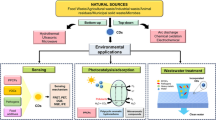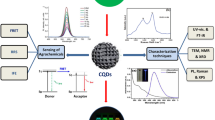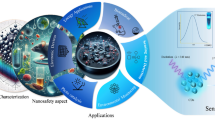Abstract
The authors describe a fluorometric method for determination of the activity of alkaline phosphatase (ALP) and its inhibitors. Nitrogen and boron co-doped carbon dots (C-dots) with excitation/emission peaks at 490/540 nm act as the fluorescent probe. The C-dots were prepared by hydrothermal carbonization starting from 3-aminophenylboronic acid as the sole precursor. On the basis of the boronic acid-triggered specific reaction with cis-diols, the boronic acid modified C-dots can bind to ascorbic acid that is generated by ALP-catalyzed hydrolysis of ascorbic acid 2-phosphate. This results in particle aggregation and quenching of fluorescence. If the ALP inhibitor Na3VO4 is introduced into the system, the activity of ALP is reduced and the fluorescence of C-dots recovers. This fluorometric method allows for the determination of ALP activity in the range from 0.2 to 6.0 mU mL−1 with a detection limit of 0.16 mU mL−1. The IC50 value for the inhibitor Na3VO4 is 3.6 μM. The method is convenient and cost-effective. It does not require complicated operations and in our perception widens the scope of applications of C-dots in bioanalytical sciences.

Schematic presentation of the nitrogen and boron co-doped carbon dot-based fluorometric method for determination of alkaline phosphatase (ALP) activity.







Similar content being viewed by others
References
Kang EB, Choi CA, Mazrad ZAI, Kim SH, In I, Park SY (2017) Determination of Cancer cell-based pH-sensitive fluorescent carbon nanoparticles of cross-linked polydopamine by fluorescence sensing of alkaline phosphatase activity on coated surfaces and aqueous solution. Anal Chem 89:13508–13517
Li SJ, Li CY, Li YF, Fei J, Wu P, Yang B, Ou-Yang J, Nie SX (2017) Facile and sensitive near-infrared fluorescence probe for the detection of endogenous alkaline phosphatase activity in vivo. Anal Chem 89:6854–6860
Tang ZW, Zhang HF, Ma CB, Gu P, Zhang GH, Wu KF, Chen MJ, Wang KM (2018) Colorimetric determination of the activity of alkaline phosphatase based on the use of cu(II)-modulated G-quadruplex-based DNAzymes. Microchim Acta 185:109
Zhao JH, Wang S, Lu SS, Bao XF, Sun J, Yang XR (2018) An enzyme cascade-triggered fluorogenic and chromogenic reaction applied in enzyme activity assay and immunoassay. Anal Chem 90:7754–7760
Zhang N, Si YM, Sun ZZ, Chen LJ, Li R, Qiao YC, Wang H (2014) Rapid, selective, and ultrasensitive fluorimetric analysis of mercury and copper levels in blood using bimetallic gold-silver nanoclusters with “silver effect”-enhanced red fluorescence. Anal Chem 86:11714–11721
Cai YY, Feng LP, Hua Y, Liu H, Yin MY, Lv XX, Li S, Wang H (2018) Q-graphene-loaded metal organic framework nanocomposites with water-triggered fluorescence turn-on: fluorimetric test strips for directly sensing trace water in organic solvents. Chem Commun 54:13595–13598
Fan C, Lv XX, Liu FJ, Feng LP, Liu M, Cai YY, Liu H, Wang JY, Yang YL, Wang H (2018) Silver nanoclusters encapsulated into metal-organic frameworks with enhanced fluorescence and specific ion accumulation toward the microdot array-based fluorimetric analysis of copper in blood. ACS Sens 3:441–450
Feng LP, Sun ZZ, Liu H, Liu M, Jiang Y, Fan C, Cai YY, Zhang S, Xu JH, Wang H (2017) Silver nanoclusters with enhanced fluorescence and specific ion recognition capability triggered by alcohol solvents: a highly selective fluorimetric strategy for detecting iodide ions in urine. Chem Commun 53:9466–9469
Feng LP, Liu M, Liu H, Fan C, Cai YY, Chen LJ, Zhao ML, Chu S, Wang H (2018) High-throughput and sensitive fluorimetric strategy for microRNAs in blood using wettable microwells array and silver nanoclusters with red fluorescence enhanced by metal organic frameworks. ACS Appl Mater Interfaces 10:23647–23656
Wang HB, Li Y, Chen Y, Zhang ZP, Gan T, Liu YM (2018) Determination of the activity of alkaline phosphatase by using nanoclusters composed of flower-like cobalt oxyhydroxide and copper nanoclusters as fluorescent probes. Microchim Acta 185:102
Xu AZ, Zhang L, Zeng HH, Liang RP, Qiu JD (2018) Fluorometric determination of the activity of alkaline phosphatase based on the competitive binding of gold nanoparticles and pyrophosphate to CePO4:Tb nanorods. Microchim Acta 185:288
Xue Q, Cao XY, Zhang CL, Xian YZ (2018) Polydopamine nanodots are viable probes for fluorometric determination of the activity of alkaline phosphatase via the in situ regulation of a redox reaction triggered by the enzyme. Microchim Acta 185:231
Zhang HT, Xiao P, Wong YT, Shen W, Chhabra M, Peltier R, Jiang Y, He YT, He J, Tan Y, Xie YS, Ho D, Lam YW, Sun JP, Sun HY (2017) Construction of an alkaline phosphatase-specific two-photon probe and its imaging application in living cells and tissues. Biomaterials 140:220–229
Gao ZW, Sun JY, Gao M, Yu FB, Chen LX, Chen QG (2018) A unique off-on near-infrared cyanine-based probe for imaging of endogenous alkaline phosphatase activity in cells and in vivo. Sensors Actuators B Chem 265:565–574
Liu SY, Wang XY, Pang S, Na WD, Yan X, Su XG (2014) Fluorescence detection of adenosine-5′-triphosphate and alkaline phosphatase based on the generation of CdS quantum dots. Anal Chim Acta 827:103–110
Sun JY, Mei H, Gao F (2017) Ratiometric detection of copper ions and alkaline phosphatase activity based on semiconducting polymer dots assembled with rhodamine B hydrazide. Biosens Bioelectron 91:70–75
Liu HJ, Li M, Xia YN, Ren XQ (2017) A turn-on fluorescent sensor for selective and sensitive detection of alkaline phosphatase activity with gold nanoclusters based on inner filter effect. ACS Appl Mater Interfaces 9:120–126
Halawa MI, Gao WY, Saqib M, Kitte SA, Wu FX, Xu GB (2017) Sensitive detection of alkaline phosphatase by switching on gold nanoclusters fluorescence quenched by pyridoxal phosphate. Biosens Bioelectron 95:8–14
Xiao T, Sun J, Zhao JH, Wang S, Liu GY, Yang XR (2018) FRET effect between fluorescent polydopamine nanoparticles and MnO2 nanosheets and its application for sensitive sensing of alkaline phosphatase. ACS Appl Mater Interfaces 10:6560–6569
Sun XC, Lei Y (2017) Fluorescent carbon dots and their sensing applications. TrAC Trends Anal Chem 89:163–180
Yu HJ, Shi R, Zhao YF, Waterhouse GIN, Wu LZ, Tung CH, Zhang TR (2016) Smart utilization of carbon dots in semiconductor photocatalysis. Adv Mater 28:9454–9477
Li HT, Sun CH, Ali MT, Zhou FL, Zhang XY, MacFarlane DR (2015) Sulfated carbon quantum dots as efficient visible-light switchable acid catalysts for room-temperature ring-opening reactions. Angew Chem Int Ed 54:8420–8424
Choi Y, Kim S, Choi MH, Ryoo SR, Park J, Min DH, Kim BS (2014) Highly biocompatible carbon nanodots for simultaneous bioimaging and targeted photodynamic therapy in vitro and in vivo. Adv Funct Mater 24:5781–5789
Ruan SB, Qian J, Shen S, Zhu JH, Jiang XG, He Q, Gao HL (2014) A simple one-step method to prepare fluorescent carbon dots and their potential application in non-invasive glioma imaging. Nanoscale 6:10040–10047
Ding CQ, Zhu AW, Tian Y (2014) Functional surface engineering of c-dots for fluorescent biosensing and in vivo bioimaging. Acc Chem Res 47:20–30
Loo AH, Sofer Z, Bousa D, Ulbrich P, Bonanni A, Pumera M (2016) Carboxylic carbon quantum dots as a fluorescent sensing platform for DNA detection. ACS Appl Mater Interfaces 8:1951–1957
Xie C, Nie B, Zeng LH, Liang FX, Wang MZ, Luo LB, Feng M, Yu YQ, Wu CY, Wu YC, Yu SH (2014) Core-shell heterojunction of silicon nanowire arrays and carbon quantum dots for photovoltaic devices and self-driven photodetectors. ACS Nano 8:4015–4022
Jin JJ, Chen C, Li H, Cheng Y, Xu L, Dong B, Song HW, Dai QL (2017) Enhanced performance and photostability of perovskite solar cells by introduction of fluorescent carbon dots. ACS Appl Mater Interfaces 9:14518–14524
Feng T, Ai XZ, An GH, Yang PP, Zhao YL (2016) Charge-convertible carbon dots for imaging-guided drug delivery with enhanced in vivo cancer therapeutic efficiency. ACS Nano 10:5587–5587
Hua XW, Bao YW, Wee FG (2018) Fluorescent carbon quantum dots with intrinsic nucleolus-targeting capability for nucleolus imaging and enhanced cytosolic and nuclear drug delivery. ACS Appl Mater Interfaces 10:16924–16924
Qian ZS, Chai LJ, Huang YY, Tang C, Shen JJ, Chen JR, Feng H (2015) A real-time fluorescent assay for the detection of alkaline phosphatase activity based on carbon quantum dots. Biosens Bioelectron 68:675–680
Qu FL, Pei HM, Kong RM, Zhu SY, Xia L (2017) Novel turn-on fluorescent detection of alkaline phosphatase based on green synthesized carbon dots and MnO2 nanosheets. Talanta 165:136–142
Tian T, He Y, Ge YL, Song GW (2017) One-pot synthesis of boron and nitrogen co-doped carbon dots as the fluorescence probe for dopamine based on the redox reaction between Cr(VI) and dopamine. Sensors Actuators B Chem 240:1265–1271
Liu ZP, Liu LL, Sun MH, Su XG (2015) A novel and convenient near-infrared fluorescence "turn off-on" nanosensor for detection of glucose and fluoride anions. Biosens Bioelectron 65:145–151
Zhang J, He LF, Zhang X, Wang JP, Yang L, Liu BH, Jiang CL, Zhang ZP (2017) Colorimetric and SERS dual-readout for assaying alkaline phosphatase activity by ascorbic acid induced aggregation of ag coated au nanoparticles. Sensors Actuators B Chem 253:839–845
Liang MJ, Ren Y, Zhang HJ, Ma YX, Niu XY, Chen XG (2017) One-step synthesis of nitrogen, boron co-doped fluorescent carbon nanoparticles for glucose detection. Luminescence 32:1031–1038
Miliutina M, Ejaz SA, Iaroshenko VO, Villinger A, Iqbal J, Langer P (2016) Synthesis of 3,3′-carbonyl-bis(chromones) and their activity as mammalian alkaline phosphatase inhibitors. Org Biomol Chem 14:495–502
Acknowledgments
This work was financially supported by the National Natural Science Foundation of China (21705056), the program for Young Taishan Scholars of Shandong Province, the Natural Science Foundation of Shandong Province (ZR2017MB022, ZR2018BB057 and ZR2018PB009) and the start-up funding from University of Jinan (511-1009408, 511-1009424).
Author information
Authors and Affiliations
Corresponding authors
Ethics declarations
The author(s) declare that they have no competing interests.
Additional information
Publisher’s note
Springer Nature remains neutral with regard to jurisdictional claims in published maps and institutional affiliations.
Electronic supplementary material
ESM 1
(PDF 421 kb)
Rights and permissions
About this article
Cite this article
Ni, P., Xie, J., Chen, C. et al. Fluorometric determination of the activity of alkaline phosphatase and its inhibitors based on ascorbic acid-induced aggregation of carbon dots. Microchim Acta 186, 202 (2019). https://doi.org/10.1007/s00604-019-3303-2
Received:
Accepted:
Published:
DOI: https://doi.org/10.1007/s00604-019-3303-2




